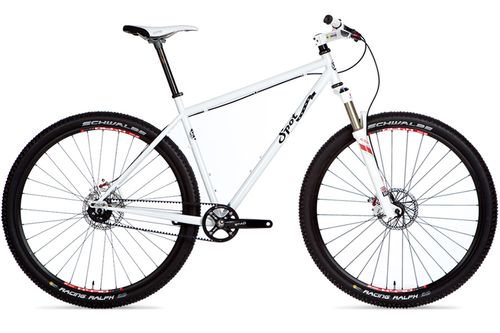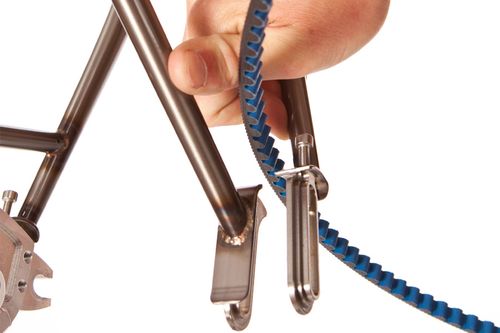For the Buyer's Guide and Spring Bike Special, we test bikes extensively (think 20-some testers and dozens of rides per bike), but it can feel like speed dating, with not enough time to really get to know a bike. So I've hung onto a handful of compelling products for ongoing testing. What follows is the first installment of the Six Month Test, in which I'll present a more comprehensive review of a product's nuances, durability, and personality.听

Given the Gear Junkie's recent mention of Gates Carbon Drive CenterTrack belt, it seemed appropriate to start with the Spot Rocker SS听($3,600 complete; $1,400 frame only), which is the first production bike to employ the technology. As a steel hardtail, single speed 29er, the Rocker SS is retro on paper, but the truth is that the design cues and belt technology make it as modern as the sleekest carbon full-suspenion trail bike. I found this out first hand in the last half year of riding this bike around New Mexico, Colorado, and Arizona.
For those unfamiliar with them, belt drives replace a bike's chain and chainrings with a carbon fiber belt (much like the ones used in your car) and pulley system.听The advantages: belt drives are clean (no chain lube), they're quiet (no metal-on-metal grinding), they're simple, and the transfer of power feels immediate. The drawbacks: Since belts can't be disconnected and put back together like chains, they require special frame designs that allow the rear triangle to open up for the belt to be installed (which means more cost, fewer frame options, as well as the potential for added flex in the frame), and past belts were finicky in their set-up and prone to slipping and alignment problems.
I'm happy to report that the Spot Rocker SS has gracefully resolved both of these problems. Thanks to the CenterTrack design, which adds a recessed center channel and shaped fins, the belt tracks 100 percent straight on its pulleys. In half a year of hard riding, the CenterTrack belt stayed perfectly aligned without a single adjustment. Spot solved the frame design issue with a trick little part called the Kobe Slider dropout. In short, these dropouts allow the frame to open and close, and they provide a tensioning device for the belt that operates independently of that frame opening. That means once the belt is installed and aligned, removing the wheel (for tire changes) doesn't ruin the set-up. One added benefit: the Kobe Sliders can be replaced with standard dropouts so you can opt to ride the frame with gears down the line should you ever lose your single speeding mojo.

An elegant solution for installing the belt.
In addition to the new belt, which was geared at 46 x 28, our Rocker SS came equipped with WTB's Laser TCS 29-inch wheels, Avid Elixir CR brakes, a RockShox Reba Race 29er fork with 15mm through-axle, and other bits and pieces from Truvativ and WTB (the Silverado saddle is a perpetual favorite; the Bronson tires seem like great all-arounders, but not perfect for the hard-packed trails of New Mexico). These choice parts, combined with the high-end steel tubing of the frame, added up to a bike that felt both substantial enough to float through jangly trails but light enough to grind out punchy climbs. And for those who feel that carbon fiber is the only choice these days, don't forsake metal yet; the steel's mix of rigidity and rough-taming forgivingness felt just right in this application. The gearing (equivalent to a 32 x 17 on a 26er), on the other hand, proved a bit too stiff for me on the steepest pitches, especially since the wheels aren't exactly gossamer (around 1700g for the pair). But Spot offers easier gear ratios if you're so inclined, and the combination of the through-axle fork and the stiff hoops made for sharp razor tracking in corners and confident descending even when the trail was chattery.
And my Rocker SS saw no shortage of chattery, rugged trails. More than once I headed up the flanks of Santa Fe Ski Hill for a “quick ride,” and ended up busting out four and five hours of saddle time on the web of whoop-dee-doo singletrack and rutted fire roads strung across the peak. Again, the biggish gearing felt like a push on these longer climbs, though thanks to the nicely balanced geometry and the Bronson tire's affinity for the loamy soil up high, the bike gripped the dirt like Velcro and I found myself able to ride a surprising amount of technical bits, even when I was out of the saddle. The downhills were just as surprising: Where I expected to be spun out and distanced by friends, I actually kept pace fine, partly because the Reba fork soaked up the small bumps and tracked beautifully through skittery switchbacks and gravely turns. The bike really excelled on the rolling desert single track closer to Santa Fe, and in the foothills around Albuquerque, where the shorter climbs made the gearing easier to stay on top of and the quick turns and constant rolls turned into pump track-style riding. Everywhere I took it, the Rocker SS persuaded me once and for all that the only way to ride a hardtail is in the 29er format; the big wheels really add a comfort that 26-inches just can't match.
One important disclaimer: I am not a single speeding masochist. I have ridden single speeds in the past and owned a couple over the years, but I generally prefer at least a few gears to ease the burdens of steep ups and downs. However, the longer I had the Rocker SS, the more often I found myself opting for the one speed instead of gears. That's partly because of the belt drive: the simplicity, the immediacy of power transfer, and the silence on the bike make this technology, to my mind, the ultimate solution for single speeding.
There's more to the Rocker SS than just it's drivetrain, though, from the uncomplicated finishes to the freedom of riding fewer, good solid parts. It's an experience that took me back to my earlier days of biking, when I didn't have to worry over derailleur complications and sag measurements but could just grab the bike and go. In that sense, the Rocker SS transcends the questions of technology and puts the soul back into riding.
Of course $3,600 is pricey for a steel hardtail with no gears. There are cheaper single speeds on the market, but I'm convinced that the Spot Rocker SS, with it's refined belt drive system and its enduring qualities, will prove a wise investment over time, partly because it will continue to perform for years and years, but mostly because it's not a bike you're likely to outgrow soon.听Dozens and dozens of bikes come through my garage each year, and the Rocker SS is one of the bikes I'll miss most now that it's gone.
–Aaron Gulley
听
听